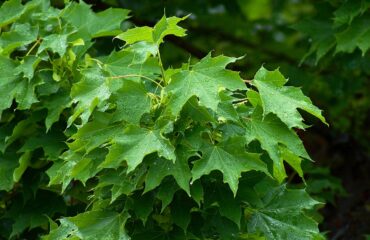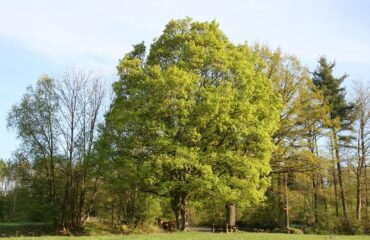Acanthus spinosus, commonly known as Spiny Bear’s Breeches, is a perennial herbaceous plant native to the Mediterranean region. It is admired for its deeply lobed, glossy dark green leaves, which have spiny edges, and its tall, architectural flower spikes. The flower spikes bear hooded, white to pinkish flowers with purple bracts and can reach up to 4 feet (1.2 meters) in height. Spiny Bear’s Breeches is often used in borders, as a focal point in garden beds, and in architectural plantings due to its striking form and texture.
Preferred Growing Conditions:
- Soil Type: Prefers rich, moist, well-draining soil; thrives in loamy, slightly acidic to neutral soil.
- Sunlight: Grows best in partial shade; can tolerate full sun if provided with adequate moisture but needs protection from intense afternoon heat.
- Temperature: Hardy in USDA zones 6-9; prefers temperate climates and can tolerate light frost.
- Water Needs: Moderate; requires regular watering to keep the soil consistently moist but not waterlogged.
Acanthus Spinosus (Spiny Bear’s Breeches) Propagation Methods:
1. Seed Propagation:
Growing Acanthus spinosus from seeds is possible, though it requires patience as the plants can take a few years to mature and flower.
- Seed Collection and Preparation:
- Collect seeds from mature flower heads in late summer to early autumn once the seed pods have dried and turned brown.
- Gently open the seed pods to release the large, dark seeds.
- Clean and dry the seeds for a few days before planting or store them in a cool, dry place for spring planting.
- Sowing Techniques:
- Fill seed trays or small pots with a light, well-draining seed-starting mix.
- Sow the seeds on the surface of the soil and cover lightly with a thin layer of soil or sand.
- Keep the soil consistently moist but not waterlogged.
- Place the trays in a bright location with temperatures around 65-75°F (18-24°C).
- Germination Requirements:
- Seeds typically germinate within 4-8 weeks under optimal conditions.
- Provide consistent moisture and protection from direct sunlight during germination.
- Once seedlings emerge, keep the soil moist and provide bright, indirect light.
- Care for Seedlings:
- When seedlings have developed several true leaves and are sturdy enough to handle, transplant them into individual pots or directly into the garden.
- Choose a location with similar growing conditions to the parent plant, such as a partially shaded area with well-drained soil.
- Note that seedlings grown from seeds may take 2-3 years to reach maturity and flower.
2. Root Cuttings:
Propagating Acanthus spinosus from root cuttings is an effective method, especially for producing multiple plants from a single root system.
- Timing:
- Best done in late winter or early spring when the plant is dormant.
- Preparation:
- Dig up the plant and clean the roots.
- Select thick, healthy roots and cut them into 2-3 inch sections.
- Allow the cut surfaces to dry and callous over for a few hours before planting.
- Planting:
- Plant the root cuttings horizontally in pots filled with a light, well-draining potting mix.
- Cover lightly with soil and water to settle the soil.
- Place the pots in a cool, shaded area.
- Rooting and Growth:
- Roots will begin to develop over several weeks, and new shoots should appear in spring.
- Once new growth is visible, gradually acclimate the plants to normal growing conditions and transplant them into larger pots or directly into the garden.
3. Division:
Division is a straightforward and effective method for propagating Acanthus spinosus, especially for established clumps. This method helps rejuvenate the parent plant and produce new plants with identical characteristics.
- Timing:
- The best time for division is in early spring before new growth begins or in early autumn after the flowering season.
- Method:
- Carefully dig up the entire clump of the plant, taking care not to damage the roots.
- Shake off excess soil to expose the root system.
- Use a sharp knife or garden spade to divide the clump into smaller sections, ensuring each division has several shoots and a portion of roots.
- Remove any dead or damaged roots and foliage.
- Replanting:
- Replant the divisions immediately in prepared soil enriched with compost or organic matter.
- Plant at the same depth as the original clump, spacing divisions 18-24 inches apart to allow room for growth.
- Water thoroughly to settle the soil around the roots.
- Care After Division:
- Keep the newly planted divisions well-watered as they establish.
- Mulch around the base to retain soil moisture and regulate temperature.
- Protect from strong winds and harsh sunlight during the initial recovery period.
4. Tissue Culture:
Tissue culture is an advanced propagation method used primarily in commercial settings to produce large numbers of uniform plants quickly. This method involves growing plant tissues in a sterile, controlled environment.
- Process:
- Small pieces of plant tissue, typically from the growing tips or meristem, are sterilized and placed in a nutrient-rich, sterile medium.
- Under controlled conditions, the tissue forms a callus, which then differentiates into shoots and roots.
- Once the plantlets are large enough, they are transferred to soil or a suitable growing medium to acclimate to normal growing conditions.
- Advantages:
- Produces a large number of uniform plants quickly.
- Can propagate disease-free plants and maintain rare or desired characteristics.
Care for Newly Propagated Plants:
- Place new plants in a location with partial shade and well-draining soil.
- Water regularly to keep the soil consistently moist but not waterlogged.
- Protect from strong winds and extreme temperature fluctuations.
- Apply a balanced, slow-release fertilizer in spring to encourage healthy growth and development.
- Mulch around the base to retain moisture and regulate temperature.
Common Challenges and Solutions:
- Powdery Mildew: Ensure good air circulation around plants and avoid overhead watering. Treat with fungicides if necessary.
- Root Rot: Ensure good drainage and avoid waterlogging, especially in heavy soils.
- Pests: Monitor for common pests like aphids, slugs, and snails. Treat infestations with insecticidal soap or neem oil.
Additional Tips:
- Prune back spent flower spikes after blooming to encourage new growth and prevent seed formation.
- Mulch around the base to retain moisture and suppress weeds.
- Divide plants every 3-4 years to maintain vigor and prevent overcrowding.
- Acanthus spinosus is deer-resistant and makes an excellent addition to shaded borders and woodland gardens.
Conclusion:
Propagating Acanthus spinosus provides a rewarding opportunity to add these bold and architectural plants to your garden. Whether you choose to start from seeds, use root cuttings, divide established plants, or use tissue culture, with proper care and attention, Spiny Bear’s Breeches will thrive and bring their dramatic foliage and striking flowers to your landscape.
Share this article



